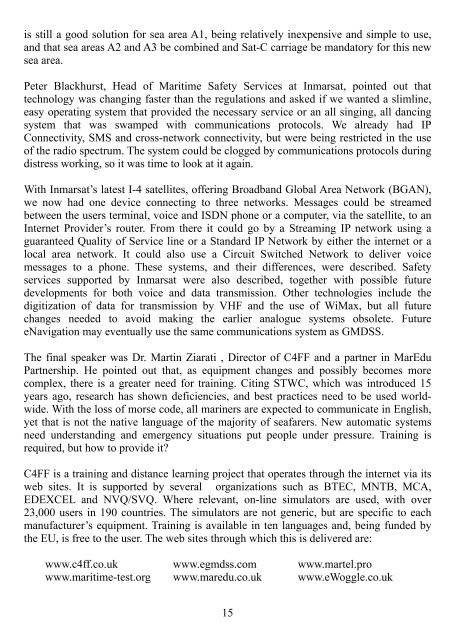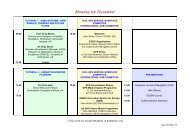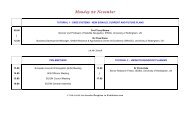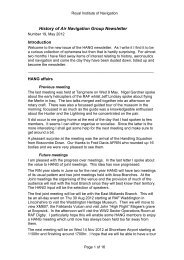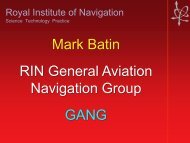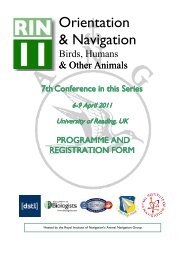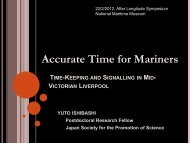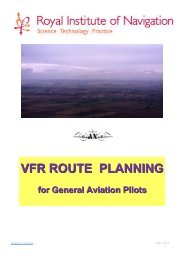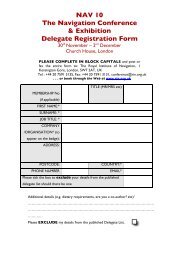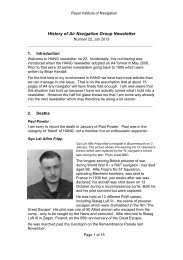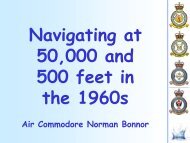Fairway 30 - Royal Institute of Navigation
Fairway 30 - Royal Institute of Navigation
Fairway 30 - Royal Institute of Navigation
Create successful ePaper yourself
Turn your PDF publications into a flip-book with our unique Google optimized e-Paper software.
is still a good solution for sea area A1, being relatively inexpensive and simple to use,<br />
and that sea areas A2 and A3 be combined and Sat-C carriage be mandatory for this new<br />
sea area.<br />
Peter Blackhurst, Head <strong>of</strong> Maritime Safety Services at Inmarsat, pointed out that<br />
technology was changing faster than the regulations and asked if we wanted a slimline,<br />
easy operating system that provided the necessary service or an all singing, all dancing<br />
system that was swamped with communications protocols. We already had IP<br />
Connectivity, SMS and cross-network connectivity, but were being restricted in the use<br />
<strong>of</strong> the radio spectrum. The system could be clogged by communications protocols during<br />
distress working, so it was time to look at it again.<br />
With Inmarsat’s latest I-4 satellites, <strong>of</strong>fering Broadband Global Area Network (BGAN),<br />
we now had one device connecting to three networks. Messages could be streamed<br />
between the users terminal, voice and ISDN phone or a computer, via the satellite, to an<br />
Internet Provider’s router. From there it could go by a Streaming IP network using a<br />
guaranteed Quality <strong>of</strong> Service line or a Standard IP Network by either the internet or a<br />
local area network. It could also use a Circuit Switched Network to deliver voice<br />
messages to a phone. These systems, and their differences, were described. Safety<br />
services supported by Inmarsat were also described, together with possible future<br />
developments for both voice and data transmission. Other technologies include the<br />
digitization <strong>of</strong> data for transmission by VHF and the use <strong>of</strong> WiMax, but all future<br />
changes needed to avoid making the earlier analogue systems obsolete. Future<br />
e<strong>Navigation</strong> may eventually use the same communications system as GMDSS.<br />
The final speaker was Dr. Martin Ziarati , Director <strong>of</strong> C4FF and a partner in MarEdu<br />
Partnership. He pointed out that, as equipment changes and possibly becomes more<br />
complex, there is a greater need for training. Citing STWC, which was introduced 15<br />
years ago, research has shown deficiencies, and best practices need to be used worldwide.<br />
With the loss <strong>of</strong> morse code, all mariners are expected to communicate in English,<br />
yet that is not the native language <strong>of</strong> the majority <strong>of</strong> seafarers. New automatic systems<br />
need understanding and emergency situations put people under pressure. Training is<br />
required, but how to provide it?<br />
C4FF is a training and distance learning project that operates through the internet via its<br />
web sites. It is supported by several organizations such as BTEC, MNTB, MCA,<br />
EDEXCEL and NVQ/SVQ. Where relevant, on-line simulators are used, with over<br />
23,000 users in 190 countries. The simulators are not generic, but are specific to each<br />
manufacturer’s equipment. Training is available in ten languages and, being funded by<br />
the EU, is free to the user. The web sites through which this is delivered are:<br />
www.c4ff.co.uk www.egmdss.com www.martel.pro<br />
www.maritime-test.org www.maredu.co.uk www.eWoggle.co.uk<br />
15


